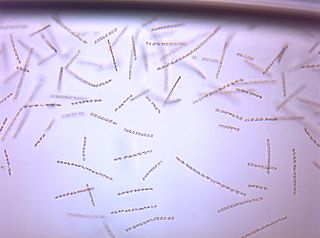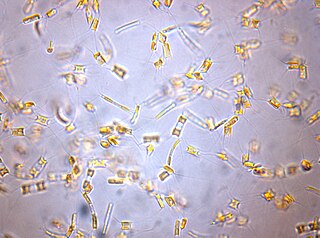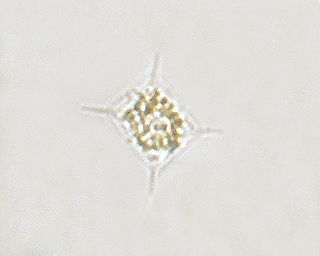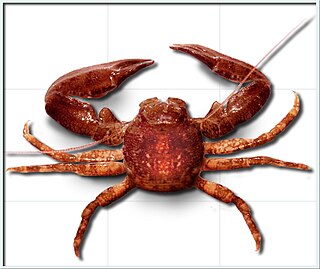
A diatom is any member of a large group comprising several genera of algae, specifically microalgae, found in the oceans, waterways and soils of the world. Living diatoms make up a significant portion of the Earth's biomass: they generate about 20 to 50 percent of the oxygen produced on the planet each year, take in over 6.7 billion tonnes of silicon each year from the waters in which they live, and constitute nearly half of the organic material found in the oceans. The shells of dead diatoms can reach as much as a half-mile deep on the ocean floor, and the entire Amazon basin is fertilized annually by 27 million tons of diatom shell dust transported by transatlantic winds from the African Sahara, much of it from the Bodélé Depression, which was once made up of a system of fresh-water lakes.

Paratrechina is one of seven ant genera in the Prenolepis genus-group from the subfamily Formicinae. Six species are included in Paratrechina; one of which, the longhorn crazy ant, is a widespread, pantropical pest.

Navicula is a genus of boat-shaped diatom algae, comprising over 1,200 species. Navicula is Latin for "small ship", and also a term in English for a boat-shaped incense-holder.

Chaetocerotaceae is a diatom family (Bacillariophyta). This family comprise the three genera Attheya T. West, Bacteriastrum Shadbolt and Chaetoceros Ehrenberg. Chaetoceros is perhaps the largest and most species rich genus of marine planktonic diatoms. The taxonomic status within Chaetocerotaceae at present is somewhat unclear.

Bolidophyceae is a class of photosynthetic heterokont picophytoplankton, and consist of less than 20 known species. They are distinguished by the angle of flagellar insertion and swimming patterns as well as recent molecular analyses. Bolidophyceae is the sister taxon to the diatoms (Bacillariophyceae). They lack the characteristic theca of the diatoms, and have been proposed as an intermediate group between the diatoms and all other heterokonts.

Attheya is a genus of small single celled diatoms. Some of these species were earlier regarded to belong to Chaetoceros, or to Gonioceros, the taxonomic status of some of these species are still debated.
Attheya arenicola is a diatom in the genus Attheya. Type material was collected from intertidal sand in Penbre, South Wales.
Attheya armata is a species of diatoms in the genus Attheya.

Attheya decora is a species of diatoms in the genus Attheya. Type material was collected from Cresswell sands, Northumberland by Mr. Atthey.
Attheya flexuosa is a species of diatoms in the genus Attheya. Type material was collected from Benllech, Gwynedd, North Wales in UK on intertidal sand.

Bacteriastrum is a genus of diatoms in family Chaetocerotaceae. There are more than 30 described species in genus Bacteriastrum, but many of these are not currently accepted, and new species are still added to the genus. The type species for the genus is Bacteriastrum furcatum Shadbolt.
Attheya gaussii is a species of diatoms in the genus Attheya.
Attheya septentrionalis is a species of diatoms in the genus Attheya.

Pisidia longicornis, the long-clawed porcelain crab, is a species of porcelain crab that lives in the north-eastern Atlantic Ocean. It varies from reddish to white, and grows to a carapace width of 1 cm (0.4 in). It was first named by Carl Linnaeus in 1767, although the etymology remains unclear.
Riedelia is a genus of diatoms known from the fossil record, comprising approximately eight species. Many of the species were originally described under the closely allied genus Hemiaulus. Paleontologists Hans-Joachim Schrader and Juliane Fenner, working with fossil specimens obtained from Leg 38 of the Deep Sea Drilling Program in the Norwegian and Greenland Seas, decided that several previous descriptions of diatoms belonging to Hemiaulus were rightfully placed on Riedelia. Schrader and Fenner note that while Hemiaulus diatoms have polygonal areolated valves, Riedelia valves are punctate with isolated punctae. Additionally, Riedelia typically have two spines, while Hemiaulus have only one. These characteristics were used to justify the placement of these species in Riedelia.
Miracula is a genus of parasitic protists that parasite diatoms, containing the type species Miracula helgolandica. More recently, the species Miracula moenusica from the river Main in Frankfurt am Main, Miracula islandica from a shore in the north of Iceland, Miracula einbuarlaekurica from a streamlet in the north of Iceland, and Miracula blauvikensis from the shore at the research station Blávík in the east fjords of Iceland were added to the genus. It is the only genus in the family Miraculaceae, of uncertain taxonomic position within the Oomycetes. They're one of the most basal lineages in the phylogeny of Oomycetes.
Copelatus longicornis is a species of diving beetle. It is part of the genus Copelatus in the subfamily Copelatinae of the family Dytiscidae. It was described by Sharp in 1882.

Thalassiosira is a genus of centric diatoms, comprising over 100 marine and freshwater species. It is a diverse group of photosynthetic eukaryotes that make up a vital part of marine and freshwater ecosystems, in which they are key primary producers and essential for carbon cycling
Temora longicornis is a species of copepod in the family Temoridae. It is found in marine environments on both sides of the Atlantic Ocean.

Diatoms belong to a large group called the heterokonts, which include both autotrophs such as golden algae and kelp; and heterotrophs such as water moulds. The classification of heterokonts is still unsettled: they may be designated a division, phylum, kingdom, or something intermediate to those. Consequently, diatoms are ranked anywhere from a class, usually called Diatomophyceae or Bacillariophyceae, to a division (=phylum), usually called Bacillariophyta, with corresponding changes in the ranks of their subgroups.











